Apple Studio Display 21 Service Manual

K Service Source
Studio Display (21" CRT, 19.8"
viewable image size)

K Service Source
Basics
Studio Display (21" CRT, 19.8"
viewable image size)
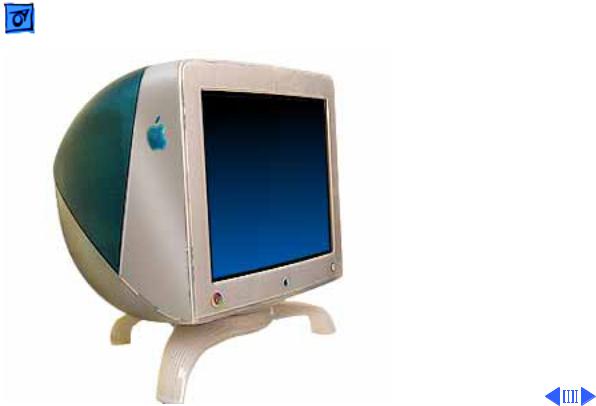
Basics |
Overview - 1 |
|
|
|
|
Overview
The Studio Display (21" CRT, 19.8" viewable image size) supports screen resolutions ranging from 640 x 480 at 60 Hz to 1600 x 1200 at 85 Hz.
The Studio Display (21" CRT) complies with TCO 99 as certified by the Swedish Confederation of Professional Employees to meet global safety tests and energy-saving features.

 Basics Overview - 2
Basics Overview - 2
Features
Features of the Studio Display (21" CRT) include
• 21-inch (19.8-inch diagonal viewable image size) Sony Trinitron CRT
• 0.25/0.27 mm variable aperture grille pitch
• four USB ports for high-speed USB devices
• horizontal scan rate of 31.5–106 kHz
• multiple resolutions
• translucent plastic housing and tripod stand
• user controls for brightness, contrast, and the Monitors & Sound control panel
• compatibility with USB-based, 1999-model Power Macintosh G3 or Power Mac G4 computers (refer to “Extended Compatibility for Service” in this chapter for more details on compatibility)
• Energy Star compliance

Basics |
|
Overview - 3 |
|
|
|
The front panel of the |
|
|
|
display includes the |
|
|
|
following controls: |
|
|
|
• power button |
|
|
Power Button |
• brightness increase and |
|
|
decrease |
||
|
|
• contrast increase and |
|
|
|
decrease |
|
|
|
• control panel launcher |
|
|
|
button |
|
Control Panel Launcher Button |
|
The control panel launcher |
|
|
|
||
Contrast Decrease Button |
Brightness Increase Button |
button opens the Monitors & |
|
Sound control panel window. |
|||
Contrast Increase Button |
|||
Brightness Decrease Button |
|
||
|
|

Basics |
Repair Issues - 4 |
|
|
|
|
Repair Issues
Caution: Out of the box, the Studio Display (21" CRT) weighs 77 pounds (35 kg). Use caution when lifting or moving the display. To move it, lift it by the hand grips on the bottom of the display. It is recommended that two people lift the monitor together.
The new exterior design features of this display include a two-color translucent housing, a tripod monitor stand, and a VGA-style video cable with a VGA-to-Macintosh adapter.

Basics |
Repair Issues - 5 |
|
|
|
|
Protecting the Translucent Housing
Important: Because the housing of this monitor is made of translucent plastic, surface scratches can be more visible than on a standard plastic housing. To avoid cosmetic damage and protect the housing during service procedures, please keep in mind the following precautions:
• Use a protective pad that is clean and free of debris whenever you service the display.
• Use caution working with metal tools to avoid scratching the housing.
• Before placing the display face down on a book or ream of paper, ensure the surface provides protection from scratches.

Basics |
Repair Issues - 6 |
|
|
|
|
New Tripod Stand Safety Tips
Because this is a new design, keep in mind the following:
• Caution: Lift the display by the hand grips under the left and right sides of the display. Never lift the display by the tripod stand.
• Caution: Do not adjust the position of the monitor by pushing or pulling the stand legs. The tripod stand is subject to cracking or breakage if mishandled.
• ±Warning: When placing the monitor on a table surface, ensure that all three legs on the tripod stand contact the surface. If one of the legs is too close to the table edge, the weight of the monitor could cause the display to fall off the edge.
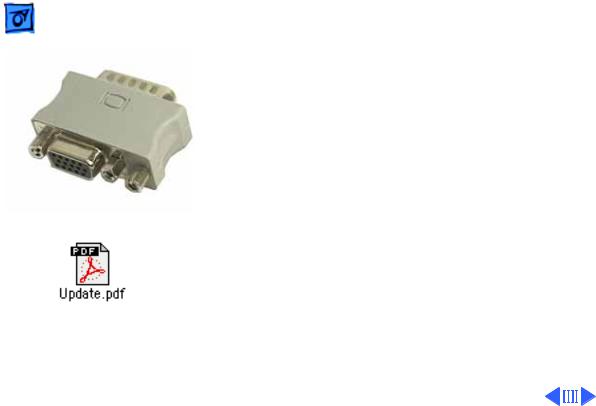
Basics |
Repair Issues - 7 |
|
|
|
|
VGA-to-Macintosh Adapter
The connector on the display cable is a VGA video connector.
To ensure the proper connection to your computer or video card, click the icon Update.pdf for instructions on using the VGA-to-Macintosh adapter that comes with the Studio Display (21" CRT).

Basics |
Repair Issues - 8 |
|
|
|
|
Find out about the Keyspan USB card at: http://www.keyspan.com
Extended Compatibility for Service
This Studio Display (21" CRT) works with USB-based, 1999-model Power Macintosh G3 or Power Mac G4 computers. These configurations are still the only approved configurations for customers using this display. However, Apple-authorized service providers may service the display using the following PCI-based Power Macintosh computers, running Mac OS 8.5 or later, with a third-party Keyspan USB card installed in the PCI slot:
• Power Macintosh 4400
• Power Macintosh 6500
• Power Macintosh 7200
• Power Macintosh 7250
• Power Macintosh 7300
• Power Macintosh 7350
• Power Macintosh 8500
• Power Macintosh 8550

Basics Repair Issues - 9
• Power Macintosh 8600
• Power Macintosh 9600
• Power Macintosh 9650
To properly set up the display to work with one of the listed Power Macintosh computers, follow these steps:
1 Confirm that the computer has at least 2 MB VRAM (required to enable all screen resolutions).
2 Install the Keyspan USB card in the PCI expansion slot. 3 Perform a clean install with Mac OS 8.5 or later.
4 Important: To avoid a system “freeze” with a blank screen, open the Energy Saver control panel and set the system sleep mode to Never.
5 Install USB driver 1.1 or later (called Mac Installer) from the disc that comes with the Keyspan USB card.

Basics |
Repair Issues - 10 |
|
|
|
|
6 |
Install Apple Displays Software 1.7.1 or later. |
|
7 |
Restart system and verify that USB ports are working. |
|

Basics |
Repair Issues - 11 |
|
|
|
|
USB Display Service Utility, version 2.1.2
In February 2000 version 2.1.2 of the USB Display Service Utility was introduced. The main difference between this version and earlier versions is the addition of PowerBook (FireWire) compatibility.
Important: Destroy previous versions of the USB Display Service Utility. To avoid loss of data, use only the latest version of the USB DSU. Refer to the Read Me file for more information. You can access the Read Me file and the latest version of the USB Display Service Utility from the Service Diagnostics page from Service Source Online.
±Warning: If you plan to use a PowerBook (FireWire) to download setup parameters, refer to “When the Second Display is a PowerBook (FireWire)” in the Adjustments chapter. You must follow that procedure to avoid loss of data or functionality.

Basics |
Repair Issues - 12 |
|
|
|
|
Apple Displays Software, version 1.8
In August 1999 version 1.8 of the Apple Displays Software was released. One of the main differences from previous versions (1.7.1 and earlier) is the name of a control panel.
The Monitors & Sound control panel (in versions 1.7.1 and earlier), used for some screen adjustments, is now called the Monitors control panel in version 1.8 and later. The features of the Monitors control panel are the same as the old Monitors & Sound control panel, except audio controls now have their own separate Sound control panel.
References in this manual that previously specified the Monitors & Sound control panel, now specify the Monitors control panel.
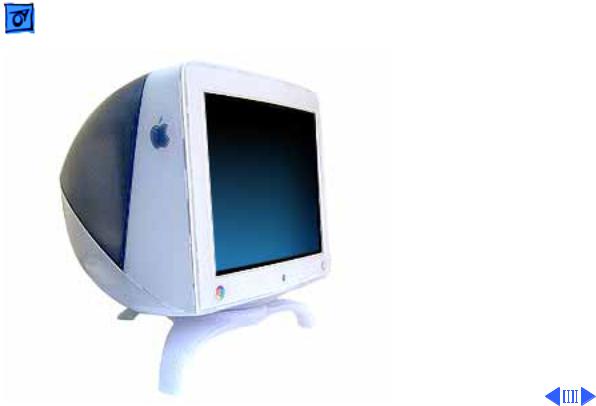
Basics |
Repair Issues - 13 |
|
|
|
|
New Housing Color
In August 1999, a new version of the Studio Display (21" CRT) was introduced. The display performance and internal circuitry remains the same as the original version. However, the new version offers a new housing color.
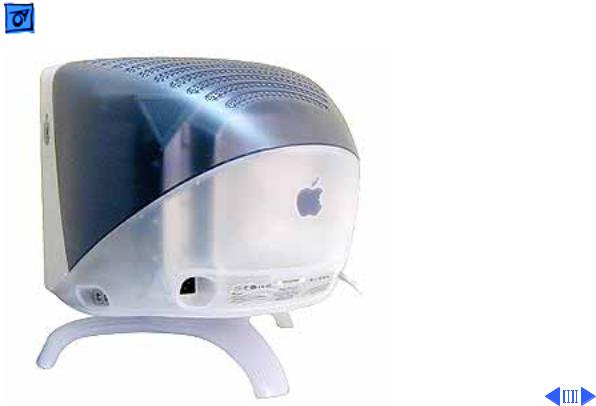
Basics |
Repair Issues - 14 |
|
|
|
|
|
Unlike the original colors of |
|
|
translucent blue and white, |
|
|
the new version of the |
|
|
display is translucent |
|
|
graphite and white. |
|
|
Important: The housing |
|
|
parts (rear housing, bottom |
|
|
housing with colored control |
|
|
panel buttons, intermediate |
|
|
bezel, front bezel, product |
|
|
ID label, and USB label) |
|
|
should be exchanged like for |
|
|
like. |
|
|
The following table shows |
|
|
the Apple part numbers for |
|
|
the housing parts that differ |
|

Basics Repair Issues - 15
by color. Finished goods number M6204LL/A represents the |
||||
original blue and white version; M6204LL/B represents |
||||
the new graphite and white version. |
|
|
||
|
|
|
|
|
|
Part Name |
M6204LL/A |
M6204LL/B |
|
|
|
|
|
|
|
Rear housing |
922-3681 |
922-3914 |
|
|
|
|
|
|
|
Bottom housing |
922-3723 |
922-3917 |
|
|
|
|
|
|
|
Intermed. bezel |
922-3726 |
922-3916 |
|
|
|
|
|
|
|
Front bezel |
922-3725 |
922-3913 |
|
|
|
|
|
|
|
Product ID label |
922-3756 |
922-3918 |
|
|
|
|
|
|
|
USB label |
922-3757 |
922-4055 |
|
|
|
|
|
|
In addition, a button panel kit (076-0805) contains one of each color of the button control panel (brightness and contrast buttons).
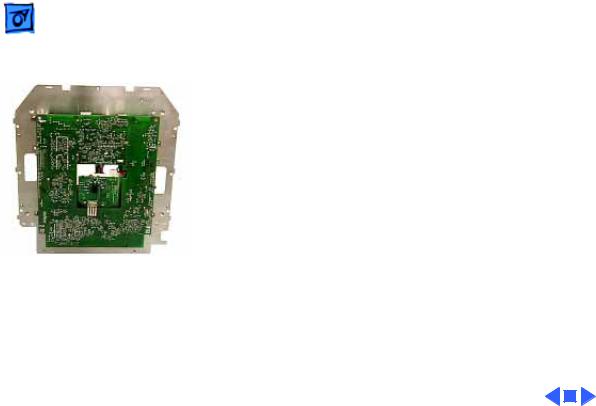
Basics |
Repair Issues - 16 |
|
|
|
|
New Version of CRT/Video Board
In November 1999, a new version of the CRT/video board was released. The new version was necessary to handle a discontinuation of a board component. Adding a different manufacturer’s component required a somewhat different board layout.
Important: Version 2 (Apple part number 661-2231) is not backward compatible with Version 1 (Apple part number 661-2116). Before replacing a CRT/video board, you must verify its version and exchange boards like for like.
For details on identifying the two boards, refer to the section “Two Versions of the CRT/Video Board” in the Troubleshooting chapter.

Basics |
U.S. Repair Strategy - 17 |
|
|
|
|
U.S. Repair Strategy
The Studio Display (21" CRT) can be serviced by AppleAuthorized Service Providers (AASPs). For those repairs that cannot be performed by the AASP (such as CRT repair/ replacement), the service facilitation process is in place.
Parts
To order replacement parts, use the AppleOrder system and refer to Studio Display (21" CRT) in the “Service Price Pages.” Large businesses, universities, and K-12 accounts must provide a purchase order on all transactions, including orders placed through the AppleOrder system.
Service providers not enrolled in AppleOrder may fax their orders to Service Provider Support (512-908-8125) or mail them to the following address:

Basics |
U.S. Repair Strategy - 18 |
|
|
|
|
Apple Computer, Inc.
Service Provider Support
Mail Stop 212-SPS
2323 Ridgepoint Drive
Austin, TX 78754
Ordering
Apple Service Providers planning to support the Studio Display (21" CRT) may facilitate service by calling 800- 919-2775.
For more details on this facilitation process, please refer to the Facilitation Process in the archived service notices section of the Service Source CD. (Open the Notices Archive folder at the top level of the Main CD. The complete path is Notices Archive: Service Notices Archive: Service Source Startup: Service Information: Notices: Service Notices: Archived List: Facilitation Process.)

Basics |
U.S. Repair Strategy - 19 |
|
|
|
|
|
If you have further questions, please call Service Provider |
|
|
Support at 800-919-2775 and select option 1. |
|
Warranty and AppleCare Protection Plan
The Studio Display (21" CRT) is covered under the Apple One-Year Limited Warranty. The AppleCare Protection Plan is also available for this product. Service Providers are reimbursed for warranty and AppleCare Protection Plan repairs facilitated for this display. For pricing information, refer to “Service Price Pages.”

Basics |
Canada Repair Strategy - 20 |
|
|
|
|
Canada Repair Strategy
The service strategy for the Studio Display (21" CRT) is module replacement. However, sometimes replacing modules may not resolve the issue. For those issues, whole-unit replacements are available. To limit “no fault found” returns on the unit, please use the following procedure when you require a whole-unit replacement:
1Troubleshoot the unit to ensure the problem is not with the software or with the computer.
2After confirming the issue is with the display, refer to Service Source Online or the Service Price Pages to order the modules necessary to repair the display.
3If the module necessary is not available, or you require a whole-unit replacement, call Technical Service Provider Support (TSPS) at 1-800-217-9517. Have

Basics |
Canada Repair Strategy - 21 |
|
|
|
|
your 10-digit service account number (beginning with 61) ready. Be prepared to explain the issue, your troubleshooting steps, and the display's serial number to the TSPS phone agent.
4After verifying the troubleshooting you've performed, the TSPS phone agent will authorize the repair by giving you the whole-unit service replacement part number, and a Vantive case number.
5Use AppleOrder to place the order for the whole-unit service replacement by manually populating the Part Number field with the part number given to you by the TSPS. Then mark the order for review, and put the Vantive case number in the Comments field. Failure to do so will result in your order being declined.
6When you receive the whole-unit service replacement, return the old display as you would any service module.

K Service Source
Specifications
Studio Display (21" CRT, 19.8"
viewable image size)

Specifications |
Introduction - 1 |
|
|
|
|
Introduction
Specifications information for the Studio Display (21" CRT) can be found in the Spec Database, which you can access in one of three ways:
• Launch it directly by double-clicking the Apple Spec Database runtime alias at the top level of the Main Service Source CD.
• Select “Apple Spec Database” from the Service Source dropdown main menu.
• Click the Acrobat toolbar icon for the database, which is near the right end of the toolbar with the letters “SP.”
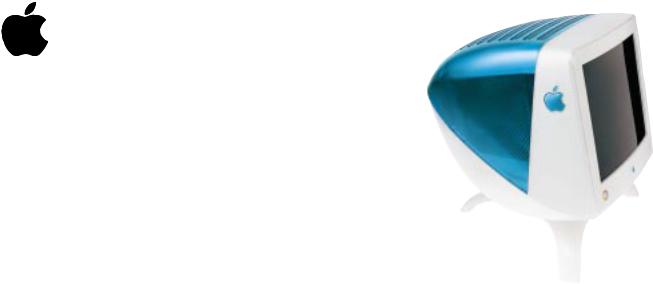
Apple Studio Display with ColorSync Technology
Features
Exceptional display quality
•21-inch (19.8-inch viewable image size) Sony Trinitron CRT
•Aperture grille technology for vivid colors and sharp text
•Vertically flat screen for reduced glare
Stunning design
•Elegant translucent case that matches Apple’s latest Power Macintosh G3 computers
•Storage space under the display for your keyboard
•Four-port USB hub for connecting peripherals
Built-in color calibration
•Uses industry-standard ColorSync color management technology
•Ensures consistent, accurate color over the lifetime of the monitor
•Saves production time by creating accurate output with fewer trials
Easy access to powerful software controls
•Single-button access to the familiar Macintosh Monitors & Sound control panel
•Intuitive control over all screen adjustments
Color is indispensable to today’s computer applications, whether you’re producing magazines, creating business presentations, or designing multimedia materials.
The Apple Studio Display with ColorSync technology is an uncompromising monitor that provides accurate color for every situation. It combines lifetime color calibration with outstanding visual performance and a stunning appearance—all for little more than competitive monitors without those features.
The first thing you’ll notice about this Apple Studio Display is its striking appearance. Its elegant translucent enclosure and sleek design complements Apple’s newest Power Macintosh G3 systems and is also highly functional. It includes a four-port Universal Serial Bus (USB) hub, and its unique stand has room underneath to store your keyboard.
The Apple Studio Display with ColorSync technology uses a 21-inch (19.8-inch viewable image size) Trinitron CRT to deliver vivid colors and sharp text. The cylindrical design of this CRT creates a vertically flat screen that minimizes glare. The end result is a monitor that’s a pleasure to view and to work with.
But the most important feature of the Apple Studio Display with ColorSync technology is its superior color accuracy—and its ability to maintain that accuracy over its lifetime. Using a patented internal measurement system, the monitor adjusts its electron beam as time passes to maintain the precise calibrations made at the factory. It can also compensate for changes in the ambient light. And because it stores its own ColorSync profiles, it can exchange accurate color information with the other devices in your production process, creating color consistency that directly translates into fewer trial-and-error stages when you output color documents.
The Apple Studio Display makes it easy to meet your specific needs and to compensate for changes in environmental conditions. A button on the display brings up the familiar Macintosh Monitors & Sound control panel on your computer, giving you powerful yet intuitive software control over all screen adjustments.
With its large screen, crisp Trinitron performance, ready-to-use USB ports, built-in color calibration, and elegant design, the Apple Studio Display with ColorSync technology is the complete monitor for demanding applications.

Ordering Information
Apple Studio Display with
ColorSync technology
Order No. M6204LL/A
•Apple Displays software
•VGA-to-Macintosh adapter
•Power cord
•Ambient light tool
•User’s setup guide
•Limited warranty
For More Information
For more information about this product, or to find out where to buy Apple products, visit www.apple.com on the World Wide Web or call 1-800-538-9696. To purchase this product from the Apple Store, go to www.apple.com/store.
Apple stands behind its products with world-class service and support. Offering quality parts, extended hardware service options, phone support, and support via the Internet, we provide you with support choices that meet your needs. For more information, visit www.apple.com/support.
Apple Computer, Inc.
1 Infinite Loop Cupertino, CA 95014 (408) 996-1010 www.apple.com
Specification Sheet
Apple Studio Display with ColorSync Technology
2
Technical Specifications
Picture tube
•21-inch (diagonal) Trinitron CRT
•19.8-inch (diagonal) viewable image size
•Variable, superfine 0.25to 0.27-mm aperture grille pitch
Resolutions and refresh rates*
•640 by 480 pixels at up to 85 Hz
•800 by 600 pixels at up to 85 Hz
•832 by 624 pixels at up to 75 Hz
•1,024 by 768 pixels at up to 85 Hz
•1,152 by 870 pixels at up to 75 Hz
•1,280 by 1,024 pixels at up to 85 Hz
•1,600 by 1,200 pixels at up to 85 Hz
Scanning rates
•31 to 107 kHz (horizontal)
•48 to 120 Hz (vertical)
User controls (hardware and software)
•Power on/off
•Brightness
•Contrast
•Horizontal size and centering
•Vertical size and centering
•Convergence
•Rotation
•Pincushion
•Keystone
•Parallelogram
•Bow
•Geometry corner correction
•Separate four-corner beam landing correction
•Overscan
•Degauss
Color controls
•Internal calibration system
•Gamma curve adjustment
•Completely variable white-point selection (4,100K to 9,300K)
•Designed for optimal reproduction of PANTONE colors
Screen treatment
•High-contrast, antireflective, antistatic coating
Connectors and cables
•15-pin mini D-Sub VGA connector
•VGA-to-Macintosh adapter
•Four-port USB hub
Electrical requirements
•Line voltage: 90V to 264V AC
•Frequency: 47 to 63 Hz, single phase
•Power: 180W (maximum) when operating; less than 30W in standby mode; less than 5W when computer is in energy-saver mode
Agency approvals
•MPR II
•CE Mark
•EPA ENERGY STAR compliant
•IEC 950
•UL1950
•CSA 950
•EN60950
•NUTEK
•TCO 99
•FCC Part 15 Class B; DOC Class B
Environmental requirements
•Operating temperature: 50° to 104° F (10° to 40° C)
•Storage temperature: 32° to 140° F (0° to 60° C)
•Operating humidity: 20% to 95% noncondensing
•Storage humidity: 5% to 95% noncondensing
•Operating altitude: 0 to 10,000 feet (0 to 3,048 m)
Size and weight
•Height: 22.3 inches (56.6 cm)
•Width: 20.1 inches (51.1 cm)
•Depth: 21.7 inches (55.0 cm)
•Weight: 77 pounds (35 kg)
System requirements
•The new Power Macintosh G3 computer with built-in USB
•Mac OS 8.0 or later
*Not all computer models and configurations are capable of driving the monitor to the highest display format it supports.
Nothing works and looks better with a new Power Macintosh G3 computer than an Apple Studio Display with ColorSync technology (sold separately).
© 1999 Apple Computer, Inc. All rights reserved. Apple, the Apple logo, ColorSync, Mac, Macintosh, and Power Macintosh are trademarks of Apple Computer, Inc., registered in the U.S. and other countries. The Apple Store is a trademark of Apple Computer, Inc. PANTONE is a registered trademark of Pantone, Inc. Trinitron is a trademark of Sony Corporation, registered in the U.S. and other countries. Other product and company names mentioned herein may be trademarks of their respective companies. Mention of non-Apple products is for informational purposes only and constitutes neither an endorsement nor a recommendation. Apple assumes no responsibility with regard to the selection, performance, or use of these products. All understandings, agreements, or warranties, if any, take place directly between the vendors and the prospective users. Product specifications are subject to change without notice.
January 1999 |
L03536B |
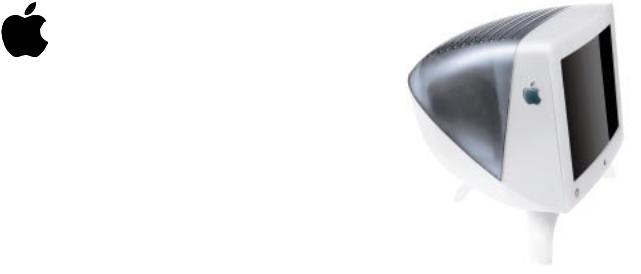
Apple Studio Display with ColorSync Technology
Features
Exceptional display quality
•21-inch (19.8-inch viewable image size) Sony Trinitron CRT
•Aperture grille technology for vivid colors and sharp text
•Vertically flat screen for reduced glare
Stunning design
•Elegant translucent case that matches Apple’s new Power Mac G4 computers
•Storage space under the display for your keyboard
•Four-port USB hub for connecting peripherals
Built-in color calibration
•Uses industry-standard ColorSync color management technology
•Ensures consistent, accurate color over the lifetime of the monitor
•Saves production time by creating accurate output with fewer trials
Easy access to powerful software controls
•Single-button access to the familiar Macintosh Monitors & Sound control panel
•Intuitive control over all screen adjustments
Color is indispensable to today’s computer applications, whether you’re producing magazines, creating business presentations, or designing multimedia materials.
The Apple Studio Display with ColorSync technology is an uncompromising monitor that provides accurate color for every situation. It combines lifetime color calibration with outstanding visual performance and a stunning appearance—all at a competitive price.
The first thing you’ll notice about this Apple Studio Display is its striking appearance. Its elegant translucent enclosure and sleek design complement Apple’s new Power Mac G4 systems and are also highly functional. The display includes a four-port Universal Serial Bus (USB) hub, and its unique stand has room underneath to store your keyboard.
The Apple Studio Display with ColorSync technology uses a 21-inch (19.8-inch viewable image size) Trinitron CRT to deliver vivid colors and sharp text. The cylindrical design of this CRT creates a vertically flat screen that minimizes glare. The end result is a monitor that’s a pleasure to view and to work with.
But the most important feature of the Apple Studio Display with ColorSync technology is its superior color accuracy—and its ability to maintain that accuracy over its lifetime. Using a patented internal measurement system, the monitor adjusts its electron beam as time passes to maintain the precise calibrations made at the factory. It can also compensate for changes in the ambient light. And because it stores its own ColorSync profiles, it can exchange accurate color information with the other devices in your production process, creating color consistency that directly translates into fewer trial-and-error stages when you output color documents.
The Apple Studio Display makes it easy to meet your specific needs and to compensate for changes in environmental conditions. A button on the display brings up the familiar Macintosh Monitors & Sound control panel on your computer, giving you powerful yet intuitive software control over all screen adjustments.
With its large screen, crisp Trinitron performance, ready-to-use USB ports, built-in color calibration, and elegant design, the Apple Studio Display with ColorSync technology is the complete monitor for demanding applications.
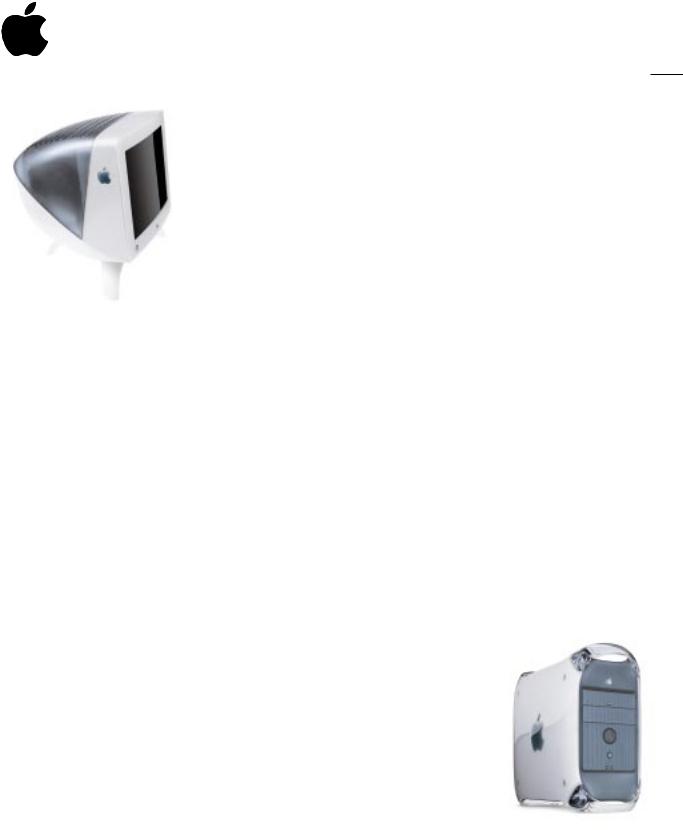
Ordering Information
Apple Studio Display with
ColorSync technology
Order No. M6204LL/B
•Apple Displays software
•Power cord
•Ambient light tool
•User’s setup guide
For More Information
For more information about this product, or to find out where to buy Apple products, visit www.apple.com/products on the World Wide Web or call 800-538-9696. To purchase this product from the Apple Store, go to www.apple.com/store.
Apple stands behind its products with worldclass service and support. Offering quality parts, extended hardware service options, phone support, and support via the Internet, we provide you with support choices that meet your needs. For more information, visit www.apple.com/support.
Apple Computer, Inc.
1 Infinite Loop Cupertino, CA 95014 408-996-1010 www.apple.com
Specification Sheet
Apple Studio Display with ColorSync Technology
2
Technical Specifications
Picture tube
•21-inch (diagonal) Trinitron CRT
•19.8-inch (diagonal) viewable image size
•Variable, superfine 0.25to 0.27-mm aperture grille pitch
Resolutions and refresh rates
•640 by 480 pixels at up to 85 Hz
•800 by 600 pixels at up to 85 Hz
•832 by 624 pixels at up to 75 Hz
•1,024 by 768 pixels at up to 85 Hz
•1,152 by 870 pixels at up to 75 Hz
•1,280 by 1,024 pixels at up to 85 Hz
•1,600 by 1,200 pixels at up to 85 Hz
Scanning rates
•31 to 107 kHz (horizontal)
•48 to 120 Hz (vertical)
User controls (hardware and software)
•Power on/off
•Brightness
•Contrast
•Horizontal size and centering
•Vertical size and centering
•Convergence
•Rotation
•Pincushion
•Keystone
•Parallelogram
•Bow
•Geometry corner correction
•Separate four-corner beam landing correction
•Overscan
•Degauss
Color controls
•Internal calibration system
•Gamma curve adjustment
•Completely variable white-point selection (4,100K to 9,300K)
•Designed for optimal reproduction of PANTONE colors
Screen treatment
•High-contrast, antireflective, antistatic coating
Connectors and cables
•15-pin mini D-Sub VGA connector
•Four-port USB hub
Electrical requirements
•Line voltage: 90V to 264V AC
•Frequency: 47 to 63 Hz, single phase
•Power: 180W (maximum) when operating; less than 30W in standby mode; less than 5W when computer is in energy-saver mode
Agency approvals
•MPR II
•CE Mark
•EPA ENERGY STAR compliant
•IEC 950
•UL1950
•CSA 950
•EN60950
•NUTEK
•TCO 99
•FCC Part 15 Class B; DOC Class B
Environmental requirements
•Operating temperature: 50° to 104° F (10° to 40° C)
•Storage temperature: 32° to 140° F (0° to 60° C)
•Operating humidity: 20% to 95% noncondensing
•Storage humidity: 5% to 95% noncondensing
•Operating altitude: 0 to 10,000 feet (0 to 3,048 m)
Size and weight
•Height: 22.4 inches (56.9 cm)
•Width: 22.6 inches (57.4 cm)
•Depth: 21.7 inches (55.0 cm)
•Weight: 77 pounds (35 kg)
System requirements
•A 1999-model Power Macintosh G3 computer or a Power Mac G4 computer with built-in USB
•Mac OS 8.5 or later
Nothing works and looks better with a new Power Mac G4 computer than an Apple Studio Display with ColorSync technology (sold separately).
© 1999 Apple Computer, Inc. All rights reserved. Apple, the Apple logo, ColorSync, Mac, Macintosh, and Power Macintosh are trademarks of Apple Computer, Inc., registered in the U.S. and other countries. The Apple Store and Power Mac are trademarks of Apple Computer, Inc. ENERGY STAR is a U.S. registered mark. PANTONE is a registered trademark of Pantone, Inc. Trinitron is a trademark of Sony Corporation, registered in the U.S. and other countries. Other product and company names mentioned herein may be trademarks of their respective companies. Product specifications are subject to change without notice.
August 1999 L04180A

K Service Source
Troubleshooting
Studio Display (21" CRT, 19.8"
viewable image size)
